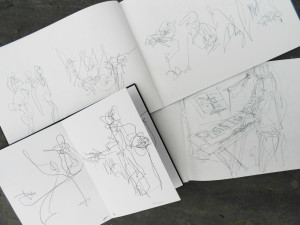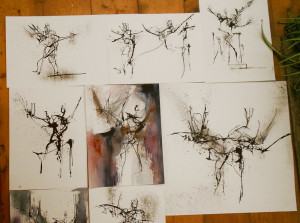q + a
Most students of my work ask the same questions, if your area of interest is not covered here please email me.
you mention ‘vibration’ and ‘energy’ a lot – what do those mean to you?
Energy and vibration are key parts of my psyche. My interest in, and study of, energy has developed over the past quarter of a century through my longterm study of Tai Ji and Qi Gong. It is there for all of us to experience if we so chose…
Vibration expresses how I hear sound – be it labelled music or noise. I am not deaf, in fact quite the reverse – certain types of sound are unbearable and extremely painful to me. This condition is recognised but I do not consider that it ‘needs curing’ and instead chose to wholeheartedly embrace the positives it brings me.
how do you go about painting mucisians?
All my work starts with drawings from life, I always have a sketchbook in my pocket. With musicians I love attending rehearsals, sound checks and masterclasses as these give me a deeper insight into the personality of the musician rather than just seeing the glossy performance persona. I draw quickly with a biro, without looking at my work, virtually non-stop during the performance.
Later, back in my studio, I select scribbles that interest me and, using them as a starting point, I begin painting on larger sheets of paper. I never plan out the finished artwork, instead I find the journey as I attempt to convey the movement, sounds, vibrations and energy of the performance as challenging and satisfying as arriving at the destination itself.
what does landscape mean to you?
Gosh, that’s a huge question and I don’t even know how to begin to answer it. After leaving London I know it took me over ten years of living in west Wales before I felt ready to begin expressing my feelings about it in my paintings. I find this quotation by Bob Fulton, an aerial cinematographer (and saxophonist) haunting:
“God created poetry by crushing beauty and sadness together so deeply that only the most exquisite poets are later able to distinguish their sources.”
why do you paint horses?
I honestly don’t know. I didn’t even realise my sketchbooks are full of drawings of horses until a fellow artist pointed it out to me. I think the following poem from a Chinese Horoscope book sums it up perfectly.
THE HORSE
“I am the Kaleidoscope of the mind.
I impart light, colour and perpetual motion.
I think, I see, I am moved by electric fluidity.
Constant only in my inconstancy
I am unshackled by mundane holds,
Unchecked by sturdy, binding goals.
I run unimpeded through virgin paths.
My spirit unconquered – My soul forever free.
I AM THE HORSE”
do you do your work on the spot or in your studio?

My approach is initially spontaneous and gestural as I fill sketch books with quick drawings made on the spot – maybe out in the countryside or at a live music performance. These sketches are necessary in order to start connecting deeply with my chosen subject matter.
Back in my studio, after a necessary period of gestation, these drawings are used as triggers to the memory of experiences, and act as the starting point for the paintings. With my work I am not trying to create a realistic image but much more than that. I am seeking to probe the hidden layers to get at the essence of my subject. Working is series is my preferred method of working.
Initially employing expressive mark making using unconventional drawing tools, such as the pipette inside ink bottles, I begin the exciting journey of development. I revel in the freedom of walking the tightrope between expected results and the uncontrolled and unexpected that can and does occur by going with the flow.
Strong expressive use of colour and energetic mark making are vitally important to me, as is my continued practice of drawing which I find essential in order to keep my hand and eye singing in tune.
how has Tai Ji affected your work?
‘Tai Ji affects my whole lifestyle.’ It has been a calming, balancing influence which helps me to work in a more productive and focussed way. I always find things in my studio go much better after I have done my tai ji practice, my meditation and Qi Gong in the morning.
what’s the nicest thing anyone’s ever said about your work?
This isn’t so much about my work as about me as a person, and I took it as a huge compliment. On going into a gallery who were interested in seeing my work, one of the owners immediately said to me “ I know you – I recognise your stillness.” It turned out that I had worked with her during a Tai Chi class several years earlier.
what keeps you painting?
The bills that keep coming through the door!
Joking aside, I paint because I have a deep need to, I don’t have a choice. I feel decidedly peculiar if I don’t paint and draw on a regular basis. My daily practice of drawing, walking, and tai chi are what keep me sane.
what is the most valuable lesson learnt?
Sir Terry Frost, when judging the Art West Open: “Rejection is the best teacher.”
what is the most poignant comment made about your work?
A fellow artist was looking at my work during my Open Studio event one year. He was very enthusiastic about it, admiring the bold gestural marks and gritty expressive use of colour. Suddenly he turned to me and said “Is your husband here? I would love to meet the artist”.
He was totally floored when I told him that I was the Andie who painted them. He couldn’t believe they had been painted by a woman. I can still see his blushes now! I saw it as a very positive comment that my work does not come across with any obvious gender issues.
For more information on Source, please visit the following pages:




